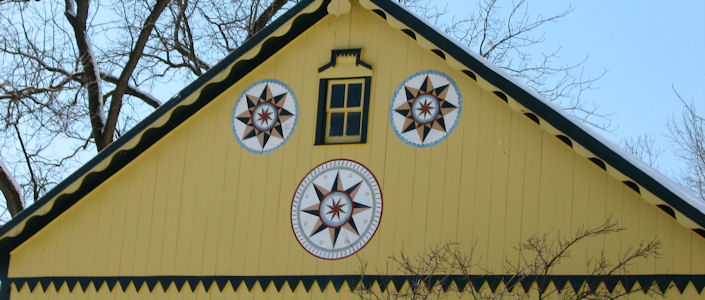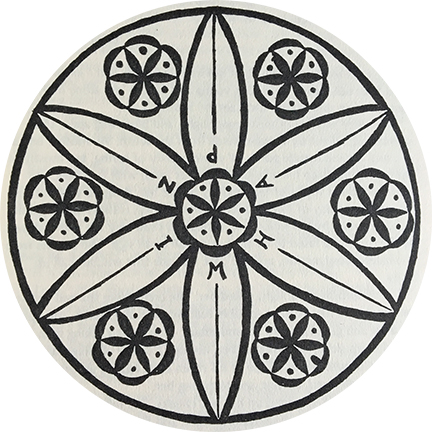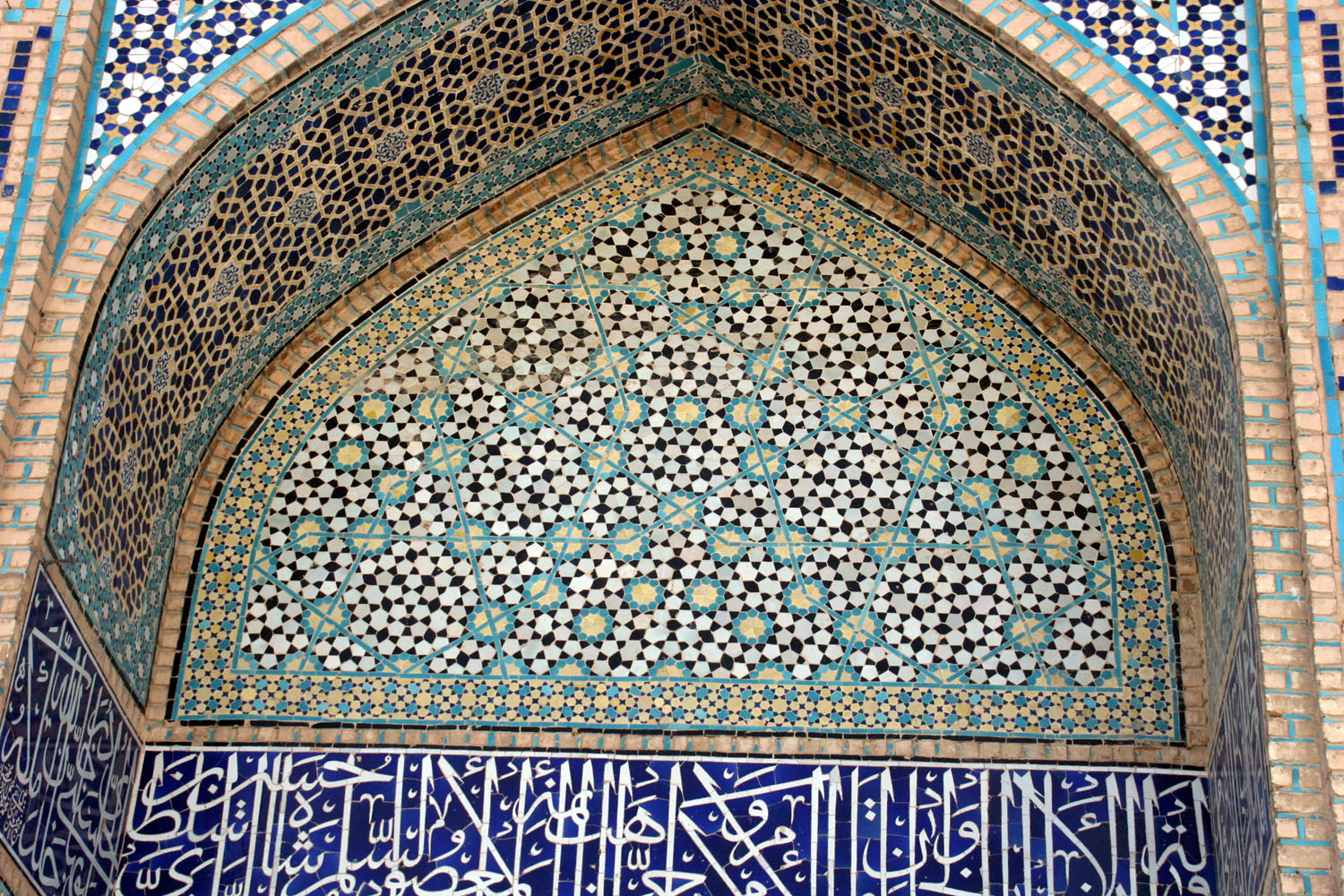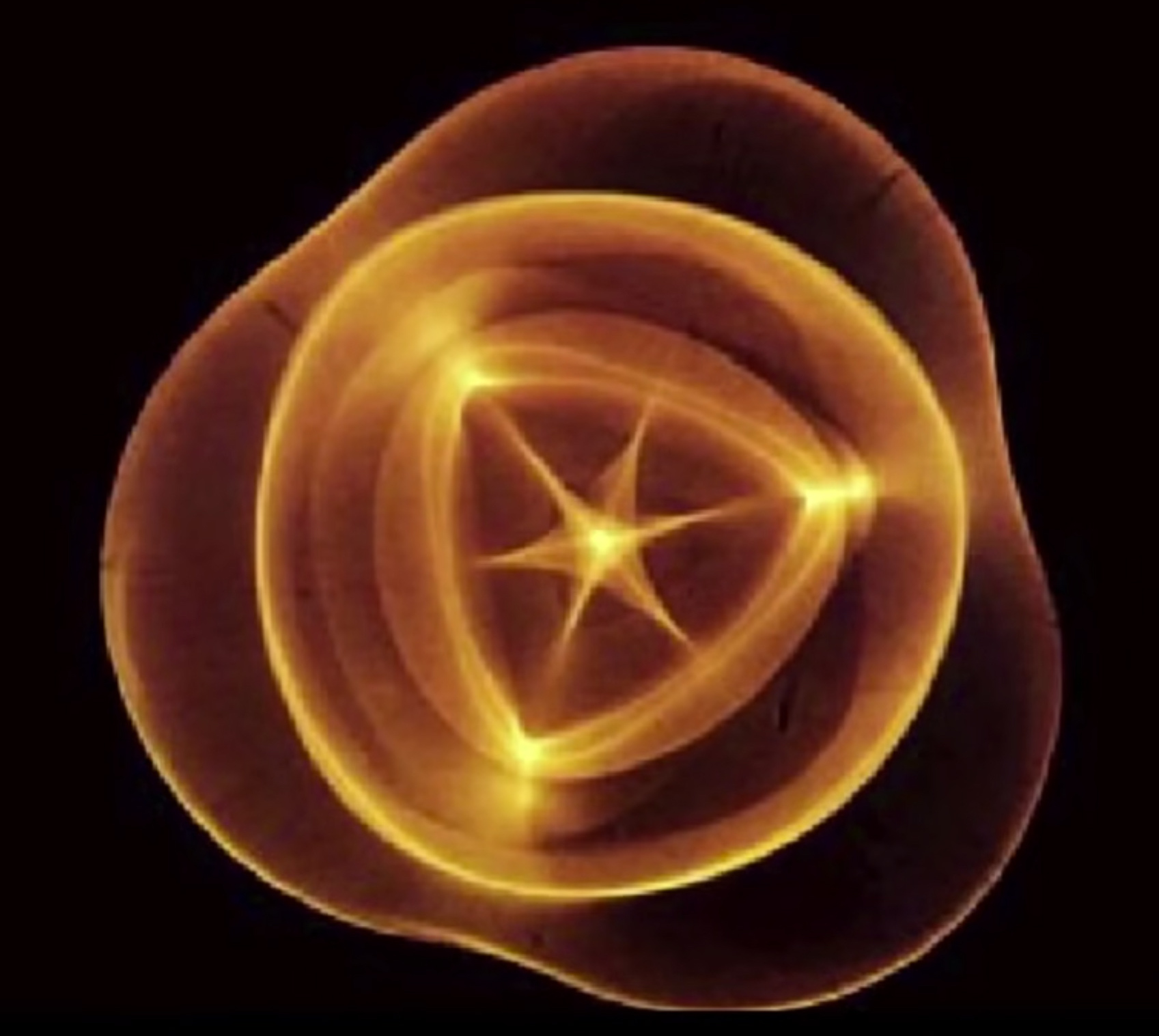Painted Prayers
Pennsylvania Dutch Hex signs are round, brightly colored geometrical symbols, which are found painted on barns, carved into furniture and drawn on documents such as birth and marriage certificates in the Southeastern region of Pennsylvania. The symbols are supposed to bring luck, love, abundance, rain, and ward off misfortunes such as fire and lightning. This paper proposes to report what is known about the signs, their origins, meaning, use, and the process by which they are created, and further to search out a possible explanation of the roots of their imagined power.
The main sources of my research are Hex Signs Pennsylvania Dutch Barn Symbols and Their Meaning, by Don Yoder and Thomas E. Graves, which was commissioned by the American Museum of Folk Art in New York in 1981, and is considered a definitive scholarly treatise on the topic. Strange Experience-The Autobiography of a Hexenmeister by R. Lee Gandee, and published in 1971 is the autobiography of an actual hexenmeister (hex-master in German). In his book Gandee explains the process of becoming a hexenmeister, how to create a hex sign, the spiritual beliefs behind the practice, and the origins of those beliefs.
The basic graphic elements that make up a hex sign are archetypal in origin. Man and his Symbols by Carl Jung provides information on the psychological side of the archetypal shapes. Throughout the paper I will juxtapose examples of typical hexes and imagery from both nature and culture to demonstrate the essential character of the hexes components. In order to speculate on the source of the hexes power, I will touch briefly upon some simple ideas from neuroscience and quantum physics involving the brain, consciousness and matter.
In the late 1600’s a group of emigrants, predominantly farmers, from the Rhine region of Germany came to the United States to settle in Pennsylvania in pursuit of religious freedom. These emigrants became known as the “Pennsylvania Dutch”. The word “Dutch” comes from the German word for German—Deutsch. The settlers included a variety of religions, some of which were referred to as the “plain dress” –Amish and Mennonite, and others as the “fancy dress”— Lutheran and Reformed. This distinction of plain and fancy is important because the “plain” religions did not believe in hex signs, and the “fancy” ones did. There are two theories of the origin of the word hex, one it is derived from the German word for witch- hexe, the other is the geometry of the symbols often employed six-sided figures -hexagrams.
It is within this group of settlers that hex signs first appeared painted on their barns. In the region where these emigrants hailed from, the signs were used as decoration over entranceways to Germanic buildings and were placed there to act as a protective charm. “European scholars viewed the geometrical patterns on folk objects as ancient symbols of magical and protective power, with deep roots into the pre-Christian religions of Europe’s past.” (Yoder, Graves 10). It is believed that the hex signs represent a fusion of craft traditions brought together in this time and place by this particular combination of people. The brightly colored designs include a few basic symbols: the six pointed rosette, the six and eight pointed stars, a raindrop, distlefinks (finch-like birds), tulips, and hearts. The colors are chosen to represent specific energy, yellow for happiness, blue for protection and calmness, orange for success, green abundance and red for strong emotion.
Hexes are made by a hexenmeister. To become a hexenmeister one is taught by the current hexenmeister in the family. The sex of the hexenmeister must alternate from one generation to the next. Once chosen, the iconography is studied, the prayers learned, and the trainee must practice using the compass, traditionally a string and a nail. While drawing a hex, the head must be covered in deference to the Deity.
“I was taught that each design was a "painted prayer," the purpose of which was to manifest on Earth (in the physical realm) that which was asked of the Spiritual realm. Tradition proclaims that, when asked to do this work, the painter respond "I'll try" in recognition that we do not completely control our fate. A good practitioner will counsel their client first, making sure that the person is prepared to do their share to make the magick work. The Hexen do not suspend the rules by which the universe works, but rather work with them, so that someone who might desire prosperity, but be unwilling to do more than complain about their poverty and buy lottery tickets is not a particularly good candidate for having the magick work!” (dutchhexsign.com)
THE CIRCLE
A hex sign is always round. Gandee writes that “a Hex conceives God as present throughout the universe, and is manifested in every atom of which it is composed… the Hex recognized the only perfect wholeness without beginning and without end as the geometric circle.” (Gandee 315). In Sumerian times, as early as 4th millennium BC, circular designs with star shape inside appear in art. In early pagan mythology the sun wheel is the circle that represents the energy of life. Plato writes that the soul is a circle. Mystical and religious imagery designed to explain man’s place in the cosmos, or to assist in reaching a calm meditative state do this through mandalas, which begin with the circle, and move the meditator into the center of his being. In the Zen sect, the circle represents enlightenment. It symbolizes human perfection. (Jung 268). According to psychologists the circle expresses the totality of the psyche in all its aspects, including the relationship of man and all of nature. To the hexenmeister the circle is the playing field within which everything is created.
THE ROSETTE
The six-pointed rosette is the most important shape in hex design. To create the six-pointed rosette one draws a circle, the places the compass anywhere on the circumference and keeping the same radius draws an arc through the circle. Moving around the circumference from each intersection of the arcs creates a rosette. Gandee explains “In placing oneself symbolically in the center of the symbolic universe, and using the six lines…one places his ideas in the right relationship with those forces which act to create form and substance out of energy.” In his autobiography Lee Gandee transcribes the prayer that a hexenmeister silently says as he is drawing out the pattern of the hex, “This is I; my consciousness is the radius.” And as he draws the circle, he says “This is God; he surrounds me. The design that I make in the bounds of my consciousness must be laid out with reference to Him.” (Gandee 316) In hexes, the six-pointed motifs represent spirit. This symbol appears inlaid in the floor of Byzantine churches in the second century and in medieval churches as stained glass windows. The shape is seen in diagrams of matter at the atomic level.
THE SIX AND EIGHT-POINT STAR
The six pointed star is a powerful symbol simply because it is created by the intersection of two triangles, one inverted over the other and creates many sixes; six points, six triangles and a six-sided inner hexagram. Most know this as a symbol of the Jewish faith, but it dates back much further, first appearing in Egypt. It is known as the Seal of Solomon, who was a good king during pagan times. “The Star of David is an Alchemical representation of the Quintessence - the force that controls the essence of organic life. This would lend Solomon’s Seal (the Star of David) a more profound level of meaning. Is it a deliberate geometric description of the life force?”(Sterne, World-Mysteries)
Scientists have found a connection between geometrical symbols and the pictures neurons make inside the brain. When Oliver Sacks writes of his experience of migraines he describes seeing geometric patterns that are common among sufferers of these headaches. He postulates that what are known as archetypal patterns may be that because they are the pictures that begin in our brain. They are patterns that appear in virtually every culture from Islamic to Swazi, as some form of decoration. Sacks poses the question, “Do the arabesques in our own minds, built into our own brain organization, provide us with our first intimations of geometry, of formal beauty? ... the geometrical hallucinations of migraine allow us to experience in ourselves not only a universal of neural functioning, but a universal of nature itself.” (Sacks, NYtimes.com )
MIND
Now on the subject of mind and matter. The first dilemma is what is the connection of the matter of the brain, which is basically meat, and mind or consciousness? Scientists are so far from understanding this, that a few of the dozen or so theories about it discount consciousness’s causal affect on reality to varying degrees. This does not sit well with the evolutionary biologists because from their perspective consciousness would not exist if it had no causal affect on a person’s life. It also disturbs philosophers and religious people because it suggests that man is nothing more than his chemical impulses, a mere automaton, and can’t be held responsible for his actions. (Schwartz, 48-53)
The area of science that has empirical evidence of the affect of consciousness on matter is quantum physics. The most famous experiment in quantum physics is the “double slit experiment.” This is a link to view a simplified animation explaining it. (http://www.youtube.com/watch?v=DfPeprQ7oGc).
Briefly, the double slit experiment proves that the consciousness of the observer has a measurable affect on the results of the experiment. It seems that in the subatomic world the mind is what matters.
In 1937 Erwin Schrödinger, quantum physicist wrote, ‘what we observe as material bodies and forces are nothing but shapes and variations in the structure of space itself.’ (www.spaceandmotion.com) What does it take to transform the shape of space? A hexenmeister would say a prayer, fortified by a geometric device. According to Gandee “A Hex knows a thought to be a thing, -- a form with an electronic force field, and a hex sign is “a telepathic blueprint image of what he wishes materialized. The power of a hex maker lies in his ability to send and sustain the image far enough out into the universe to attract the energy required to cause the materialization.” (Gandee 315-16)
CONCLUSION
The shapes that the hexen applies are profoundly human constructions designed to manifest profoundly human desires. They are shapes that have appeared since the earliest attempts at rendering the two dimensional image. The hex images mirror the symmetries found throughout the natural world, from the tiny shapes of snowflakes to the hexagonal formations in a beehive, they are the shapes that sounds make and they begin in the chemistry of our brains.
We live in a time when popular culture has been bombarded with books offering systems of how to create the life you think you should have. The phenomenon of The Secret approaches this idea in a material sense, and Ekhardt Tolle’s The Power of Now from a more spiritual perspective. Both books, which have sold millions, focus on the power of your thinking to affect your reality. If nothing else can convince one of the power of images to manifest matter, consider the amount of money spent on media advertising in the US in 2012, over 165 billion dollars (emarketer.com.) The hexes symbols; the rosette, stars, hearts etc. are archetypes, patterns inherited from the collective unconscious and as such are not susceptible to being changed by time and place, they are from the most primitive part of our psyche, and therein lies their power. “All my experience suggests that “magic” power is derived from the action of the mind at the subconscious level …and in solitude and secrecy, the mind thinks in symbols.” (Gandee 312-13)
















